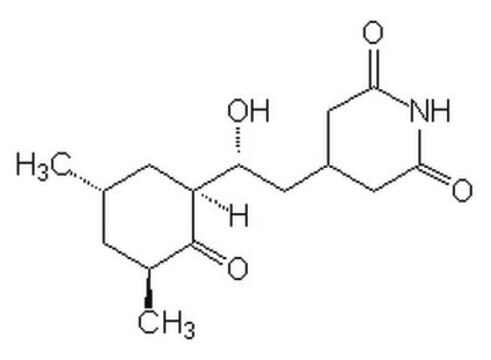239765
Cycloheximide
InSolution, 100 mg/mL in DMSO, Suitable for cell culture
Synonyme(s) :
InSolution Cycloheximide
About This Item
Produits recommandés
Niveau de qualité
Forme
solution
Fabricant/nom de marque
Calbiochem®
Concentration
100 mg/mL in DMSO
Solubilité
DMSO: soluble
Température de stockage
2-8°C
InChI
1S/C15H23NO4/c1-8-3-9(2)15(20)11(4-8)12(17)5-10-6-13(18)16-14(19)7-10/h8-12,17H,3-7H2,1-2H3,(H,16,18,19)/t8-,9-,11-,12+/m0/s1
Clé InChI
YPHMISFOHDHNIV-FSZOTQKASA-N
Description générale
Actions biochimiques/physiologiques
hFKBP12
Conditionnement
Avertissement
Forme physique
Reconstitution
Autres remarques
Lu, Q. and Mellgreen,R.L. 1996. Arch. Biochem. Biophys.334, 175.
Chow, S.C., et al. 1995. Exp. Cell Res.216, 149.
Waring, P. 1990. J. Biol. Chem.265, 14476.
Obrig, T.G., et al. 1971. J. Biol. Chem.246, 174.
Pestka, S. 1971. Annu. Rev. Microbiol.25, 487.
Informations légales
Mention d'avertissement
Danger
Mentions de danger
Conseils de prudence
Classification des risques
Acute Tox. 3 Oral - Aquatic Chronic 3 - Muta. 2 - Repr. 1B
Code de la classe de stockage
6.1C - Combustible acute toxic Cat.3 / toxic compounds or compounds which causing chronic effects
Classe de danger pour l'eau (WGK)
WGK 3
Certificats d'analyse (COA)
Recherchez un Certificats d'analyse (COA) en saisissant le numéro de lot du produit. Les numéros de lot figurent sur l'étiquette du produit après les mots "Lot" ou "Batch".
Déjà en possession de ce produit ?
Retrouvez la documentation relative aux produits que vous avez récemment achetés dans la Bibliothèque de documents.
Les clients ont également consulté
Notre équipe de scientifiques dispose d'une expérience dans tous les secteurs de la recherche, notamment en sciences de la vie, science des matériaux, synthèse chimique, chromatographie, analyse et dans de nombreux autres domaines..
Contacter notre Service technique








